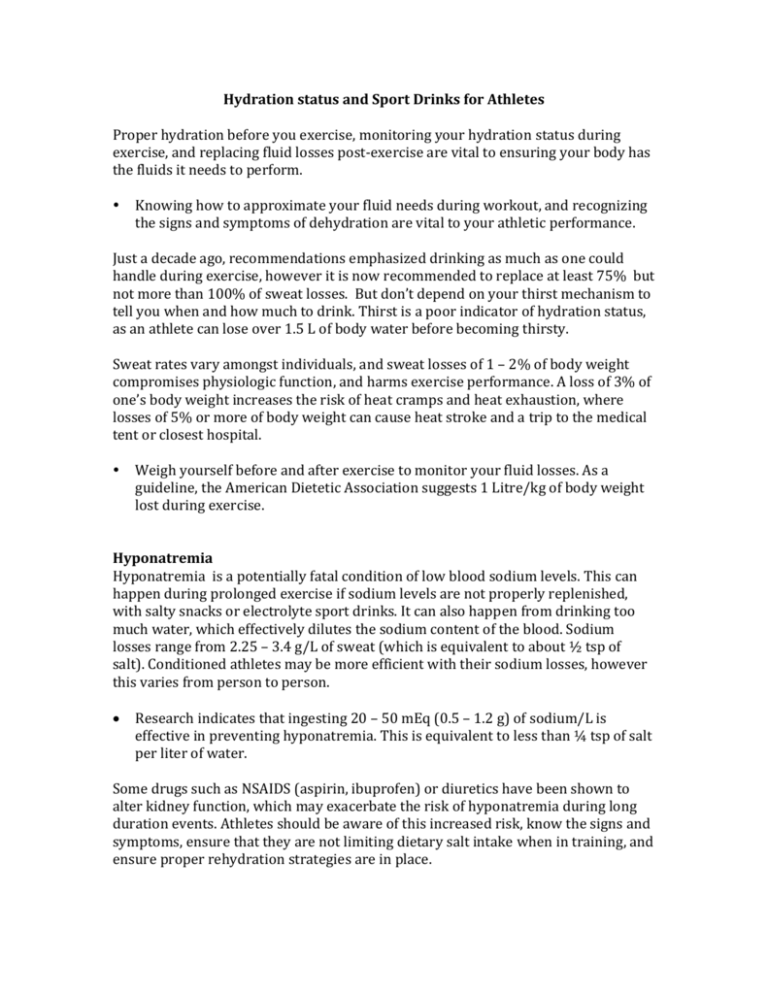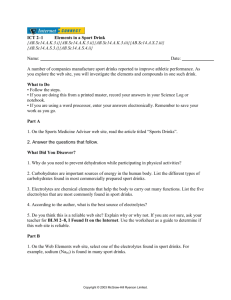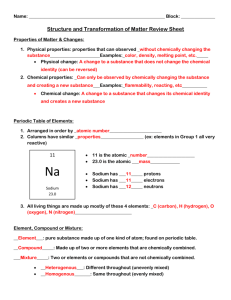Hydration status and Sport Drinks for Athletes
advertisement

Hydration status and Sport Drinks for Athletes Proper hydration before you exercise, monitoring your hydration status during exercise, and replacing fluid losses post‐exercise are vital to ensuring your body has the fluids it needs to perform. Knowing how to approximate your fluid needs during workout, and recognizing the signs and symptoms of dehydration are vital to your athletic performance. Just a decade ago, recommendations emphasized drinking as much as one could handle during exercise, however it is now recommended to replace at least 75% but not more than 100% of sweat losses. But don’t depend on your thirst mechanism to tell you when and how much to drink. Thirst is a poor indicator of hydration status, as an athlete can lose over 1.5 L of body water before becoming thirsty. Sweat rates vary amongst individuals, and sweat losses of 1 – 2% of body weight compromises physiologic function, and harms exercise performance. A loss of 3% of one’s body weight increases the risk of heat cramps and heat exhaustion, where losses of 5% or more of body weight can cause heat stroke and a trip to the medical tent or closest hospital. Weigh yourself before and after exercise to monitor your fluid losses. As a guideline, the American Dietetic Association suggests 1 Litre/kg of body weight lost during exercise. Hyponatremia Hyponatremia is a potentially fatal condition of low blood sodium levels. This can happen during prolonged exercise if sodium levels are not properly replenished, with salty snacks or electrolyte sport drinks. It can also happen from drinking too much water, which effectively dilutes the sodium content of the blood. Sodium losses range from 2.25 – 3.4 g/L of sweat (which is equivalent to about ½ tsp of salt). Conditioned athletes may be more efficient with their sodium losses, however this varies from person to person. • Research indicates that ingesting 20 – 50 mEq (0.5 – 1.2 g) of sodium/L is effective in preventing hyponatremia. This is equivalent to less than ¼ tsp of salt per liter of water. Some drugs such as NSAIDS (aspirin, ibuprofen) or diuretics have been shown to alter kidney function, which may exacerbate the risk of hyponatremia during long duration events. Athletes should be aware of this increased risk, know the signs and symptoms, ensure that they are not limiting dietary salt intake when in training, and ensure proper rehydration strategies are in place. Signs and Symptoms The signs and symptoms of dehydration and hyponatremia are very similar, and if incorrectly diagnosed can be detrimental, possibly even causing death. For example, an athlete suffering from hyponatremia can easily be mistaken as dehydrated, and drinking water, as one would do to treat dehydration, will only exacerbate the problem. Water will dilute the blood, thereby further decreasing its concentration of sodium, and worsening the symptoms of hyponatremia. Dehydration Nausea/Vomiting Cramping Confusion Headache Weakness Dizziness Fatigue Thirst Hyponatremia Nausea Cramping Confusion Headache Loss of consciousness Coma Death In this next section you will learn the theory behind sport drink formulas, to help you better plan your hydration strategy and optimize your performance safely. The “What” and the “Why” of Sport Drinks Composition of our blood: Plasma Osmolality Plasma osmolality is a measure of the concentration of sodium, chloride, potassium, glucose and other ions (molecules with a positive or negative electric charge) in the blood. This osmolality is affected by changes in water content, increasing with dehydration and decreasing with overhydration. Normal plasma osmolality ranges from 275‐300 mOsm/kg. This is similar to the osmolality of sport drinks. The kidney plays a protective role in the hydration status of the body. It helps to regulate plasma osmolality by reabsorbing water when we are dehydrated, and increases its filtration rate when we are overhydrated. Although the composition of sweat varies from person to person, it is always hypotonic (less concentrated) compared to body fluids, and therefore sweat loss increases plasma osmolality. ELECTROLYTE CONCENTRATION (mmol/L) Sodium Potassium Calcium Magnesium Chloride PLASMA SWEAT 137 ‐ 144 3.5 – 4.9 4.4 – 5.2 1.5 – 2.1 100 ‐ 108 40 ‐ 80 4 ‐ 8 3 – 4 1 – 4 30 ‐ 70 Composition of Sport drinks There are three types of sport drinks: isotonic, hypotonic, and hypertonic. • Most sport drinks are isotonic, and help to reduce the risk of water intoxication by replenishing fluids and electrolytes in a similar ratio to that normally found in the human body. Isotonic sport drinks, such as Powerade and Gatorade, contain similar concentrations of salt and sugar as in the blood. • Hypotonic drinks (<275 mOsm/kg), such as water, and Slazenger S1, are less concentrated, promote the rate of water uptake into the intestine and may be more effective in cases of severe dehydration where rapid rehydration is required. These drinks are not ideal for endurance exercise longer than 1 hour. • Hypertonic drinks (>300 mOsm/kg), such as fruit juice and chocolate milk, may cause gastric distress due to the high concentrations of sugar, and may exacerbate dehydration by stimulating less water absorption. These drinks are best suited for refueling and rehydrating after exercise. Sport drinks are a convenient way to replace water, carbohydrate, and sodium losses during and after exercise. Replacing the large amounts of sodium lost in sweat may help endurance athletes to avoid hyponatremia. Sodium also helps to maintain extracellular fluid volume, and stimulate the uptake of water and glucose into the small intestine. Dilute glucose‐electrolyte solutions, with a hypotonic osmolality compared to plasma, help to maximize the rate of water uptake. • Sport drinks are a great way to ensure both sodium and fluids are consumed, but these needs can also be met by eating salty foods and drinking water. • Studies show that optimal water and sodium uptake occurs in solutions containing 60 – 100 mmol/L of glucose, and 50 – 120 mmol/L of sodium. The type of sugar in sport drinks may also have an effect on absorption. Research shows that glucose stimulates more net water and sodium absorption than does fructose. Maltodextrin, a glucose polymer often found in sport drinks, may be the most effectively absorbed. It is less sweet than glucose or fructose, and is often mixed with other sugars to increase palatability. Maltodextrin refers to a family of glucose polymers, is composed of between 3 – 19 molecules of glucose, and is commercially manufactured from potato, corn or rice. How to make your own isotonic sport drink 1) Mix 200 mL of concentrated orange juice + 1 g (a pinch) of salt + 1 L water 2) Mix kool aid (to your taste) + 8 tsp sugar + ½ tsp salt + 250 mL water 3) Mix your favorite fruit juice + 8 tsp sugar + ½ tsp salt + 250 mL water The Good, the Bad and the Ugly­ Profile on Summer Beverages Water Advantages * Hydration * No calories Disadvantages * Low electrolyte and carbohydrate content * If bottled is environmentally unfriendly Fruit Juice * Hydration * High carbohydrate (sugar) * Vitamins concentration * Minerals * May cause GI distress (even if * Electrolytes diluted) * Antioxidants * May cause tooth enamel decay * Carbohydrate (sugar) for post‐ * Lacks most the fibre found in the exercise recovery fruit itself Fruit Drink * Hydration * Mostly sugar, artificial colors and flavors or Punch * May be fortified with some * Even if fortified, still lacks vitamins important nutrients * May cause tooth enamel decay Vitamin * Hydration * Mostly sugars, artificial colors, and flavors Water * Contains electrolytes but not sodium * Added Vitamins are not necessary‐ these vitamins are easily obtained through diet Sport * Hydrator * High in calories for inactive * Electrolytes Drinks people * Carbohydrate (sugar) for post‐ exercise recovery Energy * Central‐nervous system * Most kinds contain caffeine Drinks stimulant * Not suitable for children * Ergogenic properties Chocolate * Hydration * High in sugar (extra calories * Full of vitamins & minerals Milk may be unnecessary for non‐ * High in calcium & Vitamin D athletes) * Builds and strengthens bones * Some people are lactose * High in protein intolerant or have a cow’s milk * Helps in muscle recovery allergy * Costs less than other recovery drinks Coconut * Hydration * Only keeps for 1 day in * Full of vitamins & minerals Water refrigerator once opened * Contains natural electrolytes * Good source of fiber * Per cup: 46 calories, 9 g CHO, 0.5g fat * Tastes great Example * Tap * Dasani * Figi * Evian * Orange * Grape * Apple * Grapefruit * Fruit Punch * Orange drink * Glaceau vitamin water * Gatorade * Powerade * All Sport * Cytomax * Red Bull * Hype * Monster * Sealtest * Neilson * Quebon * Lactancia * O.N.E * Zico * Vita Coco





